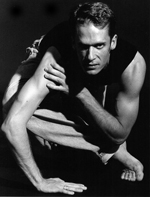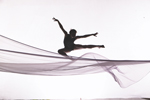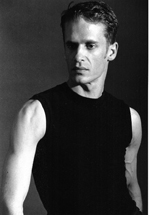 In the wake of Artistic Director Johanne Jakhelln's departure from Ballet Quad Cities after nine seasons, Executive Director Joedy Cook found a replacement in Minneapolis-based Matthew Keefe, who first worked with Cook and Ballet Quad Cities eight years ago. "I just started calling my friends in the dance world," says Cook, "and Matthew was one of the first people I called."
In the wake of Artistic Director Johanne Jakhelln's departure from Ballet Quad Cities after nine seasons, Executive Director Joedy Cook found a replacement in Minneapolis-based Matthew Keefe, who first worked with Cook and Ballet Quad Cities eight years ago. "I just started calling my friends in the dance world," says Cook, "and Matthew was one of the first people I called."
Arriving in the Quad Cities on August 23, Keefe was immediately put to work, with auditions for Ballet Quad Cities' winter performance of The Nutcracker the following evening; forthcoming projects for Keefe include a springtime collaboration between Ballet Quad Cities and the Quad City Symphony Orchestra (March 3 and 4, 2007), an original, one-act ballet based on F. Scott Fitzgerald's The Great Gatsby (dates to be determined), and the upcoming Ballet Rocks II, being held at Davenport's Capitol Theatre October 6 through 8.
With myriad academic and professional credits over the past decade, space here could be devoted to Keefe's accomplishments, which he succinctly summarizes with, "I teach, I choreograph, I dance." It could be devoted to Keefe's accidental beginnings in dance ("I was dared in college by a woman I was dating at the time," Keefe admits), or the 1999 MFA earned from the University of Iowa following years of professional performance ("It totally gave me a rebirth as a performer," he says), or how a life dedicated to dance isn't much different from anyone's ("I have a house, I'm married, I mow my lawn on weekends, I have a barbecue, I change my own oil. ... I'm not any sort of effete, artistic person.").
But better that Keefe himself reveal what makes him an ideal artistic director for Ballet Quad Cities' 2006-7 season, and what prompts Cook to remark, "After 10 years, we're finally ready for him. With the ballet company, all good things do come to those who wait."
On the need for dance
Art, in this day and age - in my vision of it - is not some rarefied thing. People like dance because dance makes them feel good. They have an instinctive understanding of what it's like. The downstage light is the big cliché in dance - that we're always "reaching for the light" - but there is something about that the audience gets. As a choreographer, I want to go back and think about how to bring uplift, and have people walking out of the theatre feeling good, and feeling that they got out of their lives for a second.
We have a 24-hour news cycle that is not good news most of the time. So what can we do as artists to bring a bit of levity to it? To show the positive? We're not just gonna bring back Swan Lake ad infinitum. I don't want pop, I don't want cotton-candy dance - I want serious dance and I want it to be thought-provoking. But I'm also not into the angst-ful, angry, oh-the-world-is-in-terrible-shape dance, you know? Nutcracker is not a story that you have to mess with. It works.
On teaching
The beautiful thing about the arts is that it really does develop a sense of empathy in you. It [dance] is a very pure, honed-down art form, and if you're rich or poor you can't tell when you walk in a room. Because you walk in there in a leotard and tights, you know, and you are what you have. You're bodies. The world is changing, and the dance world is more evolved, I think, than a lot of other aspects of the world. You're looking at people based on what kind of spark they have in them, and what they can do with their bodies. And I think that the world really needs more of it, because it is so egalitarian.
My mantra as a teacher is: "Dance is an excuse to teach." It's really not about teaching dance. That's what we're using as a vehicle to educate the students to be good people. To interact with other people, to work together as a team, you know ... to express themselves. Not everybody's verbal, so dance is a great way to express yourself in a nonverbal way.
[But] I'm always trying to get dancers to be more verbal, because that whole "shut up and dance" mentality is something of the past that I want to go away. I want people with opinions, and I want people to be willing to step up and express themselves.
On dance as a workout
 I'm always trying to debunk the stereotypes and get guys to get interested in it, because it's a wonderful athletic regime. Not everyone is inclined in sports toward competition. And the fundamental difference with dance and competition is that you're not working against an opposing force in dance. You're working toward an agreed-upon goal. Whereas sports is very much like military. You're developing a strategy working against an opposing force that's trying to thwart your efforts. I'm not saying that that's a bad thing, but dance is a fundamentally different thing.
I'm always trying to debunk the stereotypes and get guys to get interested in it, because it's a wonderful athletic regime. Not everyone is inclined in sports toward competition. And the fundamental difference with dance and competition is that you're not working against an opposing force in dance. You're working toward an agreed-upon goal. Whereas sports is very much like military. You're developing a strategy working against an opposing force that's trying to thwart your efforts. I'm not saying that that's a bad thing, but dance is a fundamentally different thing.
It's a great way to keep your mind and your body working in sync. And you're burning new synapses all the time. Every time that you try to get your body to move in a different way, you're thinking. What I try to tell students is, "I'm not teaching you how to dance. You're teaching you how to dance. I'm not Geppetto and you're not Pinocchio. I can't get you to lift your arms. You have to do it."
On his method
I do process a lot of different ways of doing choreography. I've done it with all different methods, where I've had an absolute, ironclad vision, and I go in and say, "This is what we're gonna do, precisely." Other times I go in with very loose ideas, and it's very give-and-take with the dancers - "Where do you think this is going? What do you feel needs to happen here?" Or I talk to them in really abstract ways - "I see this thing going far away, coming back, but it has to have a level change in it. How can we achieve that?" And I like feeding ideas, because it gives them [dancers] ownership. They feel like they're not just a tool. That they play a part in the creation.
On the work ethic
The old Zen mantra is: "You're entitled to the work but not the reward." The world doesn't owe you a thing. All you can do is put your best foot out there, work hard, and you know ... there's no guarantee. There's no guarantee you're gonna do five pirouettes on stage, but you can work toward it, and it might just happen. You never know.
I mean, what is the number-one fear of all adults? Public speaking. They are terrified to get in front of people and speak. Well, dancing is even worse, because here you are, stripped, usually, down to the bare minimum. And it's you and your body, and you're out there on stage in front of a big black vast expanse, and you've got to just get up there and just beam yourself out to the back row of the house. And anybody that can get out there on stage and excel, or at least give it a good fighting shot, they're gonna do well in life.
The best dancers in the world take the biggest chances on stage, and they crash more egregiously than anybody else because they go for it. If you're gonna fall, fall from the highest possible place. Lift, lift, lift, lift, lift, and if you fall, man, at least the audience will give you the sympathy vote for saying that you went for it. You're trying. If you give up, everybody knows you gave up, you know. So I demand that these kids dance with passion. Don't just phone it in.
On his position as artistic director
 There's no real training to do this job. You need to be a manager, and you need to have a vision for the art and where the art's going, but you also need to know how you fit into your community. Because we're public trusts. We exist at the good will and good graces and the funding of our community.
There's no real training to do this job. You need to be a manager, and you need to have a vision for the art and where the art's going, but you also need to know how you fit into your community. Because we're public trusts. We exist at the good will and good graces and the funding of our community.
There's a fundamental paradigm shift in the industry. [The terrorist attacks of September 11, 2001] really shook up the economic foundation of the arts. One of the trends that you'll find in the industry is that people don't buy subscriptions anymore. They're single-ticket buyers; they buy at the door. You can reap more money in the short term, but you can't plan for it. You can't budget when you don't have subscriptions. And so you never know. Every performance is a craps shoot, because you just don't know what's gonna happen. We all have to just embrace the new environment that we're in.
I think that the world is in a place right now where it needs more art. And the Quad Cities is a wonderful, growing place. They've got a feeling for wanting to have art here. I want to talk to community leaders. I want to talk to people and make the case for why this gem of a company deserves more support. It needs to have stable, long-term funding - let's really embrace this company. I want to really get out into the community and say, "We belong to all of you."
For information on Ballet Quad Cities' 2006-7 season, visit (http://www.balletquadcities.com).










